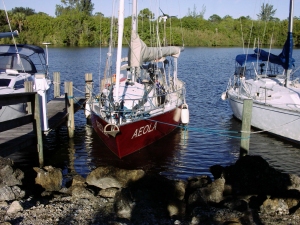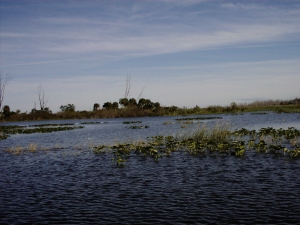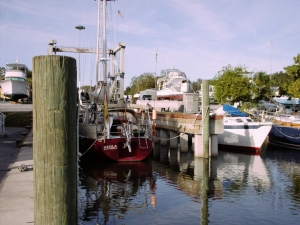Okeechobee
Waterway
Florida's Heartland
For 152 miles it winds it's way through the heart of Florida from Stuart in the East to Ft. Myers in the West. Romantic rivers (Lucie and Caloosahatchee) connect to manmade canals. Lake Okeechobee, the second largest fresh water lake in the continental US, lies right in the center. In contrast to the densely populated and more urban coastal areas this is rural Florida. Huge citrus and sugar cane plantations show where the money comes from.The dominating language in the few scattered small towns is Spanish. The grocery stores stock what Mexican farm workers, many of them illegal immigrants, consider as edible. Most of the still impressively large uncultivated areas are protected mangrove and cypress swamps and waterscapes with overwhelming flora and fauna. Never before did we encounter such a variety of birdlife, but also our first alligator not living in a zoo. You just don't go swimming here. There is also a considerable number of snakes, beware, this is wild country. The Army Corps of Engineers, that maintains most of the inland waterways, has built several small docks in the middle of nowhere. We found only one marina, Indian Town. There aren't many boats anyway.

Lucie Lock Campground dock, cheap, clean, water, electricity and shower included.


Indian Town Marina has only a few transient slips, reservation highly recommended. We had to stay in the travellift dock for that reason.
One of Floridas biggest assets is its wealth of water. During rainy season in the summer tropical downpours literally drown the amphibious landscapes of the Southwest. No problem as long as nobody was living here except nomadic Indians who knew where to go when the waters came. But with a growing and settled population every year people died. In the year 1928 alone 2400 people drowned when a hurricane hit La Belle, a small town to the South of the Lake. This is how the South Florida Water Management came into being, a complicated and highly sophisticated system of reservoirs, dams, canals and locks. So far it has been very successful in preventing another catastrophe. Part of is the Herbert Hoover Dike that circles Lake Okeechobee and reminded us much of our Northern German coastline. The actual waterway was only a byproduct, welcomed by a growing farming industry.


Almost extinguished is the native population of Seminole Indians. The deciding battle of the Second Seminole War took place in the year 1837 near the town of Okeechobee to the North of the Lake. Victorious was General Zachary Taylor, who later became 12th President of the United States.
The photos can only give you a weak impression of the vastness and sheer immeasureability of this land- and waterscape. We adored it even when it was not easy navigation at times. The waterway can be alarmingly shallow in some places. And there is one bridge with a vertical clearance of 49 ft. Now we know that our mast is 48 ft. What a hairraising moment.

endless citrus plantationsons along the way



Finally we arrive at the West Coast of Florida in the warm waters of the Gulf of Mexico. This is how we can tolerate winter.It's time for a break. Gabriele is looking for a temporary job and I have a lot of work to do on the boat.We will stay here for a while, make plans and dream of new shores, oceans and islands. Perhaps the Pacific next year...

